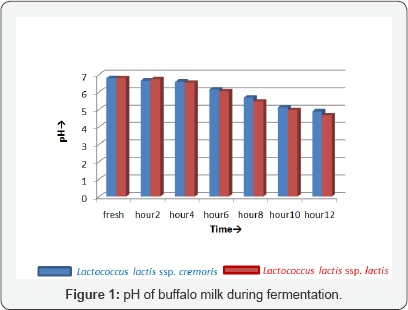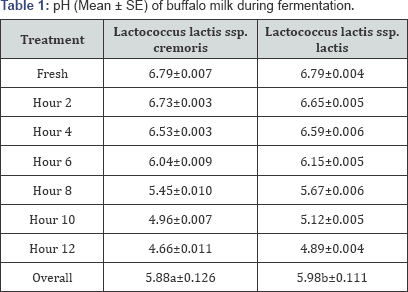Study on Proteolytic Potential of Buffalo Milk Using Lactococcus Lactis Ssp. Cremoris and Lactococcus Lactis Ssp. Lactis-Juniper Publishers
Journal of Dairy & Veterinary Sciences- Juniper Publishers

Introduction
Buffalo milk contains all the nutrients in higher
proportions than cow milk as per the nutrient components. The
compositional differences between buffalo and cow milk are reflected on
their physico-chemical properties. Milk from buffalo preferred for
preparing dairy products of western and traditional (indigenous) type
and nutritionally superior. Buffalo milk contains less cholesterol
(total cholesterol 275 mg and free cholesterol 212mg per 100g of fat) in
compared to cow milk (total cholesterol 330 mg and free cholesterol
280mg per 100g of fat) and more tocopherol (334.21|ig per kg for buffalo
and 312.3|ig per kg of cow milk). Due to high peroxidase activity,
buffalo milk can be preserved naturally for a longer period. Buffalo
milk contains more calcium, better calcium: phosphorous ratio and less
sodium and potassium than cow milk which makes it a better nutritional
supplement for infants.
Due to growth requirements, dairy starter cultures
have developed highly sophisticated proteolytic system that capable of
break down milk proteins, mainly a1 and p-caseins. The proteolytic
structure of lactic acid bacteria (LAB) and their activities in dairy
products including yogurt and cheese have been studied extensively [1-5].
Lactococcus lactis has two subspecies with few phenotype and genotype differences, Lactococcus lactis ssp. lactis and ssp. cremoris, where subsp. lactis is preferred for making soft cheese while subsp. Cremoris is for hard cheese.
Materials and Methods
Periodical evaluation of fermented buffalo milk
Fresh buffalo milk was skimmed to bring the fat
contents to below 0.5% using cream separator. The samples were heated to
boil at least for 5min to inactivate/kill the inherent microbial
population present in milk. Then Lactococcus lactis ssp. cremoris and Lactococcus lactis ssp. lactis
cultures were inoculated @ 1% and after proper mixing, the samples were
inoculated at 30 °C .The samples were drawn at 0, 2, 4, 6, 8, 10, 12
hours and were subjected to analysis for change in pH.
Bacterial cultures and their propagation
Glass ampoules containing Lyophilized powder of Lactococcus lactis ssp. cremoris NCDC 81 and Lactococcus lactis ssp. lactis
NCDC 88 were obtained from the NCDC (National Collection of Dairy
Cultures) Dairy Microbiology Division ICAR-National Dairy Research
Institute, Karnal (INDIA). The organisms were stored at 4 °C. The
propagation for each strain was performed according to Donker et al., [1]
with slight modification. Sterile 5ml aliquots of reconstituted sterile
skim milk (RSM) (Himedia Laboratories) were inoculated with each strain
individually and incubated at 30 °C for 24h in BOD incubator. After
incubation, the pre-inoculated cultures were prepared by transferring
loop full of activated culture to 10ml aliquots of litmus milk (Himedia
Laboratories) to determine the activation of culture activity by
observing change in color of litmus milk after 24 hour of inoculation Figure 1. The skim milk and litmus milk were autoclaved following the standard procedure (121°C for 15min @15lbs).

pH measurement of milk samples:
The pH of samples was measured by using combined
glass electrode of Milkoscan at camel milk research laboratory, ICAR-
NRC on Camel, Bikaner.
Result and Discussion
Change in pH during hydrolysis:

Note - Means bearing different superscripts within a row differ significantly
The data related to pH of buffalo milk has been shown in Table 1 .The pH of fresh milk was found to be 6.79±0.004 for Lactococcus lactis ssp. cremoris and 6.79±0.007 for Lactococcus lactis ssp. lactis before inoculation of treated bacteria.
The value of pH was dropped significantly as the
fermentation hour were increased and at 12 hour of fermentation and it
was observed to be 4.89±0.004 and 4.66±0.011 for Lactococcus lactis ssp. cremoris and Lactococcus lactis ssp. lactis respectively whereas the overall pH was 5.98±0.111 and 5.88±0.126 for Lactococcus lactis ssp. cremoris and Lactococcus lactis ssp. lactis respectively. The pH value demonstrated in Table 1 reveals that the rate of decrement was higher in samples, which are fermented with Lactococcus lactis ssp. cremoris comparing with Lactococcus lactis ssp. lactis, in buffalo milk samples. [6,7].
Process of fermentation is affected by several
factors including the structure of the protein, temperature, enzyme/
protein ratio, enzyme concentration and pH. In the present study, almost
linear drop in pH was observed during the fermentation process in
buffalo milk samples. The release of protons (H+ ion) and/or production
of acidic amino acids into the surrounding medium results in reduction
in the pH of the reaction mixture.

** = Significant at 1% (P<0.01).
The statistical analysis of data as shown in Table 2,
revealed that there was a highly significant (P<0.01) decrease in
the pH value of buffalo milk samples with advancement of fermentation
hours as well as between the treated bacteria that is Lactococcus lactis ssp. cremoris and Lactococcus lactis ssp. lactis. [8,9].
To know more about Journal of Dairy & Veterinary Sciences:
https://juniperpublishers.com/jdvs/index.php
https://juniperpublishers.com/jdvs/index.php
To know more about Open Access Publishers: Juniper Publishers


Comments
Post a Comment